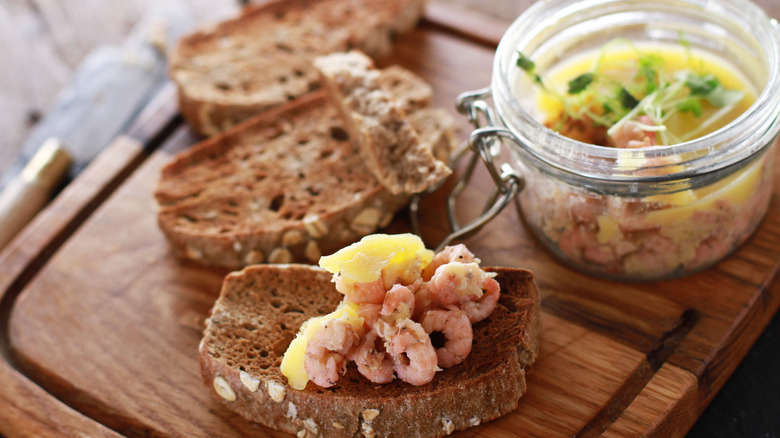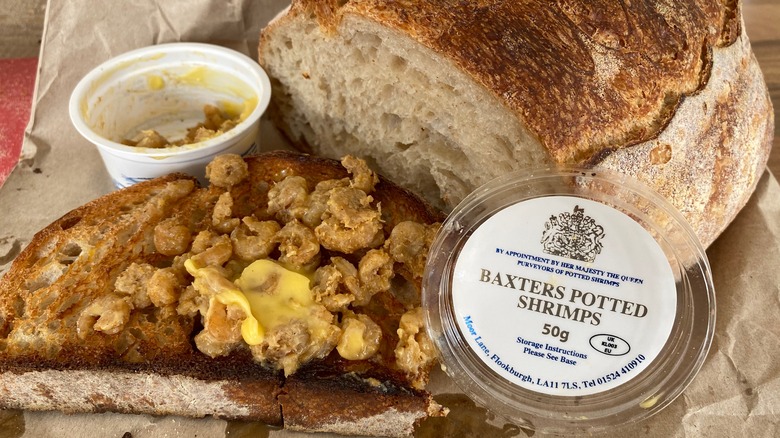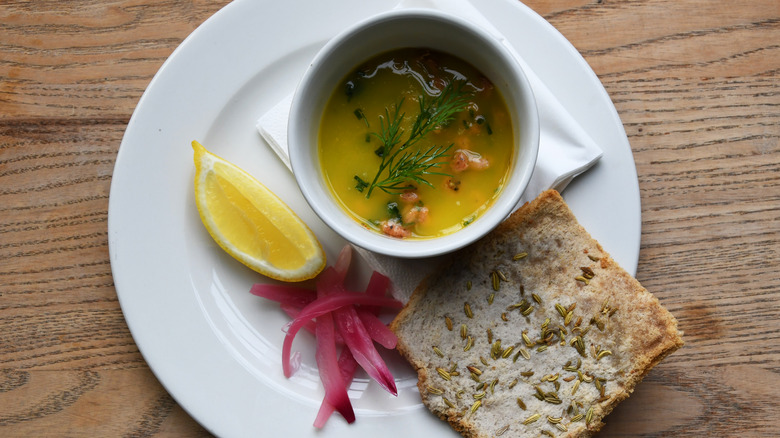The Tradition Of Potted Shrimp May Have Roots In The Tudor Period
British cuisine hasn't always had the best reputation. Outsiders can dismiss it as a meat- and carb-heavy study in beige or, as "Arrested Development" once joked, a place where "the soup of the day is bread." This isn't exactly a fair accusation, as there is plenty that the British Isles have to be proud of in the culinary sense.
Let's take stock of a few British recipes worth celebrating. Who can deny the universal appeal of malt vinegar-coated and flash-fried fish and chips or ignore the greatness of the king of all meatballs, the Scotch egg? And don't forget about bubble and squeak, an economical veggie casserole that surely wins for the most delightful name as well as being a delicious hearty dish.
There are lesser-known dishes that deserve your undivided attention as well, like the seafood delicacy known as potted shrimp. A British canapé of the highest order, potted shrimp has an illustrious—and tasty—history.
A feast for fishermen and queens
Like the old tradition of potted meat, potted shrimp was less of a recipe as it was a way to preserve precious protein. The Historic Foodie writes that potting something consisted of sealing meat, cheese, or seafood under a protective layer of butter or fat. When stored in a cool place, this impenetrable layer of fat keeps out air and microbes, preserving the protein for weeks or even months. Think of this as the Anglicized version of the French confit method.
Potted shrimp sprang up in the 16th century when Tudors ruled the Isles, but Slow Food in the UK notes it was mostly enjoyed by fishermen in the Morecambe bay area, who enjoyed the small brown Morecambe shrimp in the potted style. It only became a widely known dish in the late 19th century, when the new railways carted the potted shrimp to the fashionable tea tables of London.
Though the dish may have humble origins, it has more recently been associated with the elite upper class and royals. Queen Elizabeth II counted potted shrimp on toast as one of her absolute favorite meals. Considering this is a woman who abstained from eating all onions and garlic, the potted shrimp was a fairly adventurous choice for her. It was also beloved by another debonair British icon. According to the Independent, Ian Fleming was such an ardent fan of the potted shellfish that he made it a subsequent favorite of his most famous creation, James Bond.
Bringing potted shrimp to the home kitchen
According to the Independent, fishermen of old would boil their shrimp in briny sea water, then hand it off to their wives for it to be sealed in a crock with clarified butter. Adaptations to this formula would often incorporate spices, like nutmeg and mace, plus the citrusy addition of lemon juice. This aromatic mix can be served one of two ways: cold and slathered on toast or warm, with the melted butter bathing the succulent shrimp in a rich sauce. As the Independent notes, the sweet Morecambe shrimp are still highly prized for this recipe but are increasingly difficult to find and expensive. Due to their diminutive size, they're hard to peel and very few companies still harvest them.
If you're looking to recreate this historic classic at home, the process is relatively simple. Modern recipes are less finicky about which shrimp to use, specifying North Atlantic shrimp or prawns, and cooking the shrimp directly in the butter before potting, rather than in salted water (via BBC goodfood). Nutmeg, cayenne, and lemon juice are all common additions, but some recipes, like the New York Times Cooking, will incorporate celery seed, thyme, and anchovy into the mix. Another great tip for the New York Times? Chop your large shrimp into 1-inch pieces, so that they mimic the more delicately proportioned Morecambe shrimp.
One bite of this dish and you'll get the hype. Even after 400 hundred-plus years, potted shrimp still tastes fresh.


